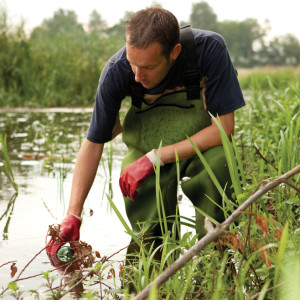 With a lush backdrop of Blue Ridge Mountains, undulating shoreline, residential and rural landscapes and wide-ranging inlets, Smith Mountain Lake is a haven for wildlife and people. Known as the “Jewel of the Blue Ridge Mountains,” landowners and commercial entities alike are concerned about keeping this “jewel” intact and pristine and are taking steps to help keep the region beautiful forever.
With a lush backdrop of Blue Ridge Mountains, undulating shoreline, residential and rural landscapes and wide-ranging inlets, Smith Mountain Lake is a haven for wildlife and people. Known as the “Jewel of the Blue Ridge Mountains,” landowners and commercial entities alike are concerned about keeping this “jewel” intact and pristine and are taking steps to help keep the region beautiful forever.
The 2,000-acre Smith Mountain Lake was created in 1963 when American Electric Power (AEP) constructed the Smith Mountain Dam and impounded the Roanoke River. Appalachian Power, a subsidiary of AEP, is licensed by the Federal Energy Regulatory Commission to operate the Smith Mountain Project, which generates power at their hydro-electricity plant to provide electricity to the region.
The lake’s proximity to Lynchburg and Roanoke as well as the myriad recreational opportunities it presents make it a popular retreat. It’s also magnet for development, as people nationwide recognize the beauty of the area and the benefits of lakeside living. Amidst the hustle and bustle of a vibrant area, environmentally sound practices help ensure that Smith Mountain Lake remains pristine. Volunteers, citizen groups and non-profits, conservation-minded developers as well as AEP have all worked through various means and initiatives that strive to keep Smith Mountain Lake green and beautiful.
 Protecting the Shoreline
Protecting the Shoreline
Appalachian Power is one organization which plays a big role in green initiatives at Smith Mountain Lake. John Shepelwich, a representative of AEP, says, “At the Smith Mountain Project we take our stewardship very seriously, and on a daily basis protect the aesthetics, environment and wildlife. As part of our Shoreline Management Plan, we focus on the scenic, environmental and life aspects of the shoreline.” The Shoreline Management Plan is a comprehensive plan intended to manage the multiple resources and uses of the lakes’ shorelines, so that they are consistent with AEP’s Federal Energy Regulatory Commission licensing requirements.
Today, the fact that Smith Mountain will remain an undisturbed natural resource is an enormous asset to the area. Smith Mountain is preserved with a conservation easement which protects the mountain from development. “Lake property owners and visitors will never see an interruption of the long tree-filled mountainside,”
says Shepelwich.
 AEP’s island protection plan is another example of this stewardship. This program involves the stabilization of islands in danger of erosion. Shepelwich explains that the islands dotting Smith Mountain Lake were at one time hilltops before the lake reached normal water level. They tend to be susceptible to erosion from both wave action and trampling by visitors. Only a few islands are privately owned; the rest are public or owned by AEP. If the islands erode too far, they could become a hazard to boaters by leaving large shallow areas in open water. Sheplewich explains that AEP has agreed to stabilize any islands that are in danger as part of its licensing agreement.
AEP’s island protection plan is another example of this stewardship. This program involves the stabilization of islands in danger of erosion. Shepelwich explains that the islands dotting Smith Mountain Lake were at one time hilltops before the lake reached normal water level. They tend to be susceptible to erosion from both wave action and trampling by visitors. Only a few islands are privately owned; the rest are public or owned by AEP. If the islands erode too far, they could become a hazard to boaters by leaving large shallow areas in open water. Sheplewich explains that AEP has agreed to stabilize any islands that are in danger as part of its licensing agreement.
Shepelwich says that AEP also offers programs that support energy efficiency, explaining that they can assist homeowners with cutting energy use at their homes. A new program allows the company to provide financial incentives to customers who are willing to cycle off their cooling/heating compressors for short periods during times of high energy usage. Another program AEP offers is for customers who use solar energy. Solar energy is fast becoming a source for power and heat in and around the lake, with some residents opting to install solar panels on their docks and open spaces of land. AEP customers who use solar power can take part in their net metering program, which enables them to sell back excess power generated by their systems.
 Monitoring Water Quality
Monitoring Water Quality
The Smith Mountain Lake Association (SMLA) is a volunteer group whose mission it is to protect property values at the lake. Water quality is top on the list of the group’s priorities. To address this, the group concentrates its efforts on water analysis, weed control and lake cleanup. The association teams up with AEP and Ferrum College to analyze water samples. According to Rich Brager, a SMLA representative, volunteers collect water samples and take them to experts at Ferrum. These studies indicate the current nitrogen, phosphorous and oxygen levels in the water and the quality of the water.
SMLA also monitors invasive weeds and works toward their eradication. In the past they used chemical herbicides
in an attempt to kill lake weeds. But last year the association purchased and released thousands of sterile grass-eating carp. “And so far they are doing their job,” says Brager.
Each spring, in conjunction with the Chamber of Commerce and the Tri-County Lakes Administrative Commission, SMLA sponsors Take Pride in Smith Mountain Lake Cleanup Day. This year’s event—the 28th annual—is slated for May 2. Volunteers converge on the lake and along its shores to gather trash. Last year, 700 volunteers collected 52 tons of debris, and this year, officials hope to have 1,000 volunteers participate.
Another project the association manages is stream monitoring. Volunteers collect invertebrates in the water, and the different species are counted and identified. Invertebrate species are often indicators of water quality. Some prefer healthy water and others prefer unhealthy water. By analyzing the counts, researchers can assess the purity of the lake water.
The association’s Buffer Landscape Committee assists homeowners in selecting native plants in accordance with the Shoreline Management Plan’s 800-foot contour buffer landscape requirements. Volunteers visit homes and offer suggestions regarding what types of plants are appropriate to install on their property, including native plants that help filter run off and aid in erosion control.
 Green Building Practices
Green Building Practices
Developers in the area are also supporting environmentally sound practices. One company that embraces green building is The Willard Companies, a lakeside developer known for well-constructed, high-end housing. By implementing sustainable design, they have earned designations from both EarthCraft, which promotes energy efficient housing, and Energy Star, which encourages the use of energy efficient products for the home. “We started our affiliation with EarthCraft and Energy Star over seven years ago and it has transformed how we build homes today,” says Ron Willard II, vice president of Willard Companies.
EarthCraft endorses energy efficiency at its best with homes that are more energy efficient, eco-friendly and less costly to live in. EarthCraft homes are very durable and use sustainable resources for building materials. Concrete with fly ash, cellulose insulation, carpets of recycled material and windows and insulation not only meeting but exceeding codes for efficiency are all part of the equation.
Energy Star appliances are also an integral part of the program. Energy Star is a program from the United States Environmental Protection Agency that helps identify and promote energy-efficient products and practices. Such choices can save families about one third on their energy bill without sacrificing features, style and comfort.
 Willard says that most homebuyers are educated on green building components and interested in all the energy efficient options available, including insulation, windows, HVAC and solar energy—but it’s how these options are combined that makes an impact on overall great design. Two new developments by The Willard Companies feature this green construction. The Grande Villas at the Water’s Edge and Hammock Point at The Farm are designed and certified in accordance with EarthCraft House and Energy Star programs. These low-impact developments are designed to create a healthy, tranquil indoor setting plus reduce utility bills to protect the environment. “Smith Mountain Lake must keep up with other surrounding markets and deliver what the customer wants in energy efficient living,” says Willard.
Willard says that most homebuyers are educated on green building components and interested in all the energy efficient options available, including insulation, windows, HVAC and solar energy—but it’s how these options are combined that makes an impact on overall great design. Two new developments by The Willard Companies feature this green construction. The Grande Villas at the Water’s Edge and Hammock Point at The Farm are designed and certified in accordance with EarthCraft House and Energy Star programs. These low-impact developments are designed to create a healthy, tranquil indoor setting plus reduce utility bills to protect the environment. “Smith Mountain Lake must keep up with other surrounding markets and deliver what the customer wants in energy efficient living,” says Willard.
 Reduce, Reuse, Recycle
Reduce, Reuse, Recycle
The county recycling program is one way that every family can become involved in keeping the lake area clean. Bedford County has numerous collection sites within the county as well as the County landfill that collects building materials and heavy items. Cardboard, mixed paper, newspaper, glass, plastic and metal cans are all recycled. Used cell phones plus batteries, both alkaline and rechargeable, can be brought to collections sites. Most sites will also take men’s and women’s clothing and shoes as well as blankets and curtains. And the landfill recycles all electronics including computers, television monitors, copiers, fax machines, VCRs, DVD players and microwaves. Franklin County recycles newspapers, cardboard, aluminum, tin and steel cans and plastic bottles and jugs. Recycling helps keep salvageable refuse out of the landfill.
Embracing green initiatives makes good sense, helping to protect the environment and in many cases homeowners’ wallets. Many entities in the area are invested in initiatives to keep Smith Mountain Lake green and pristine—protecting the water and the shoreline as well as striving for energy efficiency and conservation. And for our area, taking these steps will help ensure this lovely section of Virginia remains an extraordinary spot in perpetuity.
